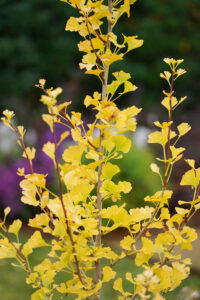Ginkgo biloba – a botanic anomaly
By Clive Larkman
The world of botany is full of commonplace plants as well as some standout weirdos. Australia has its own Wollemi Pine which was ‘discovered’ in 1994 in a nature reserve just north of Sydney. It is not really known how old these wild plants are nor how old the species is. There are fossils that date back 100 million years. It is a Gymnosperm which is the second major category of vascular plants. This in itself means it has an unusual history.
The other major category is the Angiosperm of flowering plants. Gymnosperms preceded Angiosperms by over 200 million years and include the huge group of plants known as conifers. Basically, the main difference is that Angiosperms produce flowers and protected seeds through a range of fruit structures. Gymnosperms are non-flowering and produce male and female cones which in turn produce unprotected seeds. There are far more species of Angiosperms, but none are as old as plants like the Wollemi Pine and the Chinese odd one – Ginkgo biloba.
Like the Wollemi Pine, this is a Gymnosperm which dates back over 200 million years. They were originally classed as conifers but were relatively recently put in their own division called Ginkgophyta. To illustrate their unique evolution, the plant is a single species in a monospecific genus, which is the only genus in the Order Ginkgoales, which is the solitary member of the Class Ginkgoopsida. The specific epithet refers to the bilobed foliage which has unusual, divided venation that does not form a network of veins like dicots. The lobed foliage looks similar to the leaf like structures on Maidenhair Fern, giving rise to the common name of Maidenhair Tree.
The genus name comes from the Japanese script loosely meaning Silver Apricot which refers to the soft, silver (fruit like) cones of the female plant. The Japanese pronunciation is ‘gin kyo’ and the name is known to have been used by Chinese herbologists 700 years ago. Western botanists have always pronounced it with a hard ‘k’ which gave rise to the spelling Ginkgo (which is sometimes misspelt as Gingko).
The plant is dioecious – the male plants produce sperm in small pollen cones, and the female plants produce a fruit-like structure consisting of two ovules in which the pollinated seed will grow. When the ‘fruit’ matures and drops, it quickly rots and gives off a putrid, vomit-like smell in line with that of another popular Asian plant – the durian. In mid-autumn, the unusual lobed foliage turns a brilliant gold and this is when these unpleasant ‘fruits’ are produced – it looks great from afar but not so good when walking underneath.
There are equally as many good cultivars of both sexes. Many ornamental forms are male plants that don’t produce the ‘fruit’ but do exhibit the stunning golden foliage. The female plant has the foul-smelling seeds, but the male has its own pain as it produces masses of pollen from its cone like structures which is highly allergenic, whilst the female cones rate almost zero for causing allergies. If it weren’t for the smelly ‘fruit’ or allergenic pollen, the Ginkgo tree would be one of the best ornamental trees in the world.
Ginkgo are large trees growing to a height of 20–35m, with some Chinese plants growing to over 50m. The tree has an angular crown and long branches. It is usually deep-rooted, cold resistant, and able to withstand high wind and heavy snow. The young trees will grow tall and slender before the crown spreads out as it matures. It produces relatively soft wood which has the ability to survive cold, heat, pests, and diseases, whilst also adapting to changing climates. Some individuals are reported to be more than 2,500 years old, and there are even six trees located in Hiroshima that predate the nuclear explosion that killed almost every other living thing for miles around.
As can be expected for a plant that has been around for multiple millions of years, and cultivated for several thousand, there are numerous reported uses – medicinal, culinary, and structural. The wood is used to make furniture, carving, and Sake casks. The wood is fire-resistant and decay resistant. The nut-like seeds are a traditional Chinese food and popular in many other Asian countries. They are a food, a snack, and a medicine but over-consumption can be detrimental to good health.
The plant has been grown and harvested in Asia for millennia and is part of the Asian herbal pharmacopoeia but there is little scientific support for the dozens of claims made as to its benefits. It has been suggested it has beneficial uses in treating high blood pressure, asthma, bronchitis, kidney problems, menopause-related cognitive decline, tinnitus, and altitude sickness. There is preliminary evidence for positive effects in treating dementia, and some symptoms of schizophrenia.
Again, as a plant that has been in cultivation for such a long period, it has also become ingrained in the social and cultural fabric of many Asian countries and regions. Whether the professed medical benefits are true or not, it certainly has an amazing history that forms an integral part of the study of plants and their place on the planet, and within human culture.

